This article was published as a part of the Data Science Blogathon.
Introduction
Applications of blockchain technology are evolving. Each new application is overcoming the current challenges faced by applications. Currently, while staking your crypto assets, users require a particular account of tokens to stake; these tokens are locked for a certain time and illiquid. This is where liquid staking comes in to solve the problems stated above.
In this guide, I will walk you through lido finance, a liquid staking application.
What is Liquid Staking?
To understand liquid staking, we need o know what’s staking.
Staking:
Staking is locking your cryptocurrency assets for a fixed or variable period. By doing so, stakers have rewarded a yield for staking the assets. By staking, users secure the network. The more amount of tokens staked on a network, the greater the security of the network. Network here refers to a blockchain.
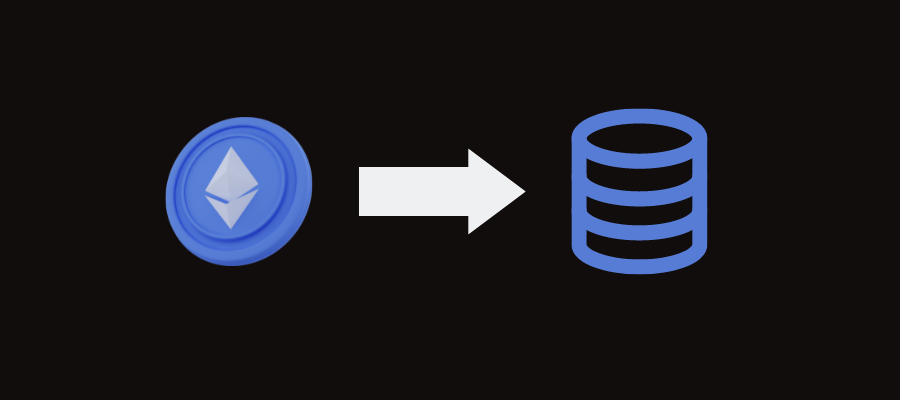
Liquid Staking:
Liquid staking removes the drawbacks of traditional staking methods. In liquid staking, once you deposit (stake) your native tokens on the platform, you receive an st token that represents their staked tokens on a 1:1 basis. Users, in addition to earning the staking yield, can earn additional yield using these st tokens. One application of the st token is discussed in the later sections of the guide.
For example, if a user stakes 2 ETH tokens, the user will receive 2 stETH tokens.
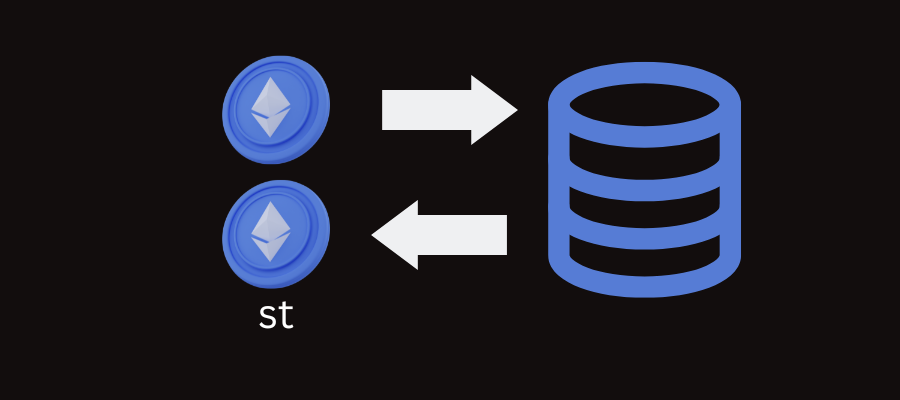
To learn more about liquid staking, click here.
What is Lido Finance?
Lido Finance is a decentralized application (dapp) that offers the feature of liquid staking. Lido currently has close to $6 Billion in total value locked (TVL) on the platform with 199k+ stakers securing the protocol. Lido has been audited by some of the industry’s top blockchain security companies, including Quantstamp and Mixbytes.

Lido currently offers liquid staking for five cryptocurrencies – Ethereum (ETH), Polygon (MATIC), Solana (SOL), Kusama (KSM), and Polkadot (DOT). Lido is working on integrating more assets and chains on the platform such as Avalanche (AVAX), Near Protocol (NEAR), and many more will be integrated in the future.
Wallet and Blockchain
Wallet:
A crypto wallet is required to interact with any Web3 protocol. To interact with Lido Finance, I will be using the Phantom Web Wallet.

Phantom is a Web3 crypto wallet built on the Solana blockchain that enables users to store, send, receive, buy and swap their crypto assets in a secure and decentralized way.
To learn more about the phantom wallet and its applications, click here.
Blockchain:
As stated above, Lido currently offers services of five blockchains. In this guide, I will be connecting the Lido protocol to the Solana blockchain to demonstrate the functions and features of Lido Finance.

Solana is a layer – 1 blockchain known as the “Ethereum Killer”. The Solana blockchain has a high TPS, transactions are quick and the transaction fees are very low (< $0.01).
Launch Lido Application
To navigate to the Lido Finance website, click here.
On navigating to the website, follow the below steps to launch the application:
- Click on the Stake now button.
- Click on the Stake now button for the respective blockchain (Solana in our case).
- You have now launched the Lido protocol for the respective blockchain selected.
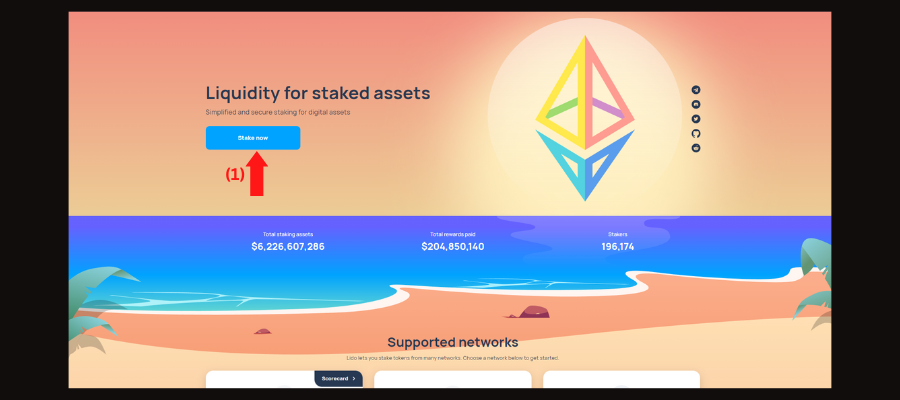
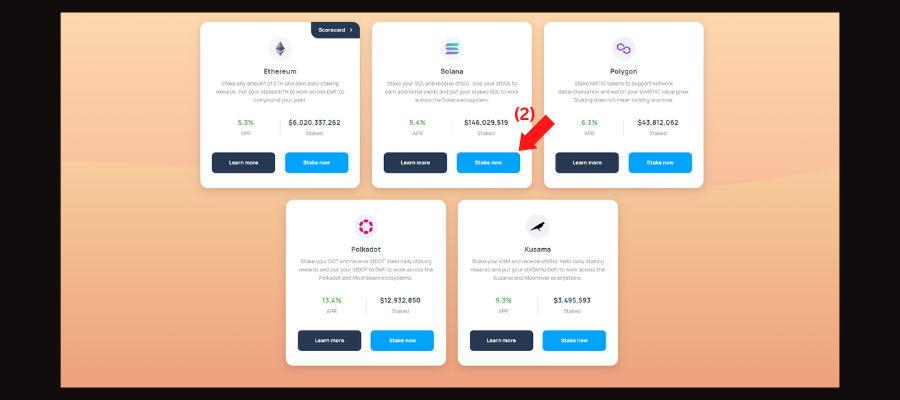

Connect Wallet to Lido
Once the application is launched, the next step is to connect your Web3 wallet to interact with the protocol.
You may connect your Web3 wallet by following the steps below:
- Click on the Connect wallet button.
- Tick the checkbox to agree to the terms and conditions.
- Select the Web3 wallet of your choice (Phantom in our case).
- Click on the Connect button in your wallet.
- Your wallet has now been connected to the protocol. You can view your wallet balance and details once it is connected to the protocol.
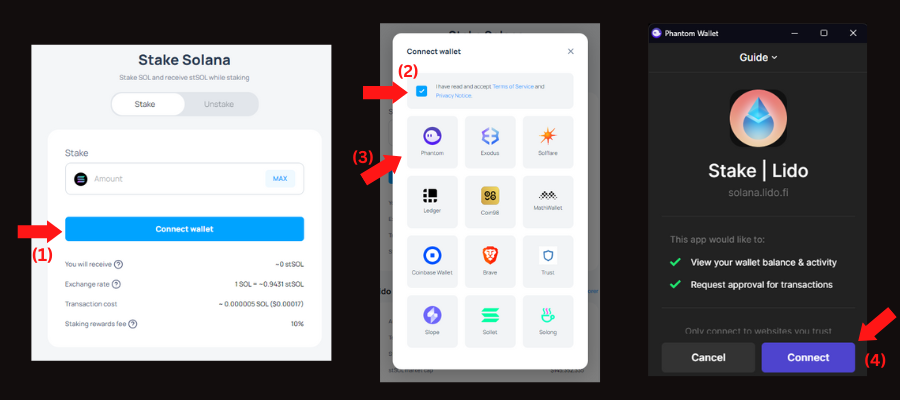
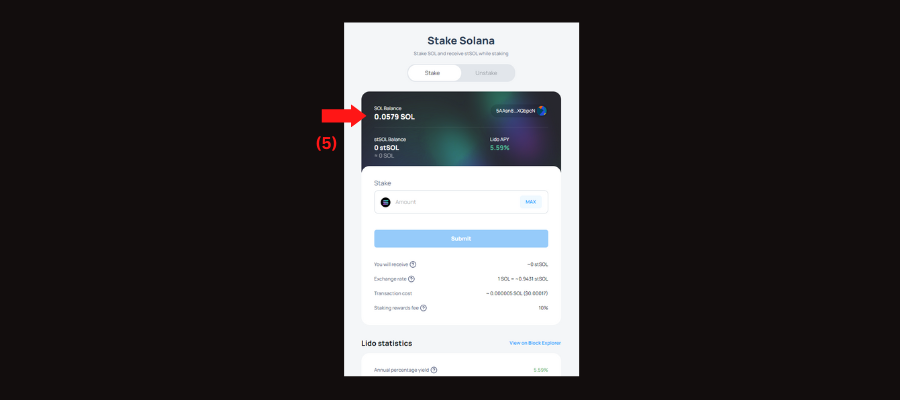
Stake Tokens
By staking your $SOL tokens, you will earn a yield on your stake as well as receive an equivalent amount of $stSOL tokens as proof you have staked the tokens. The current APY for staking $SOL tokens is ~ 5.6%.
You may stake your $SOL tokens by following the steps below:
- Enter the amount of $SOL tokens you want to stake.
- Click on the Submit button.
- Click on the Approve button in your wallet to confirm the transaction.
- Click anywhere on the screen to continue.
- You may check your wallet, the equivalent amount of $stSOL tokens has been credited to your wallet in place for the $SOL tokens.
- Furthermore, you can view your $stSOL tokens on Lido’s page.
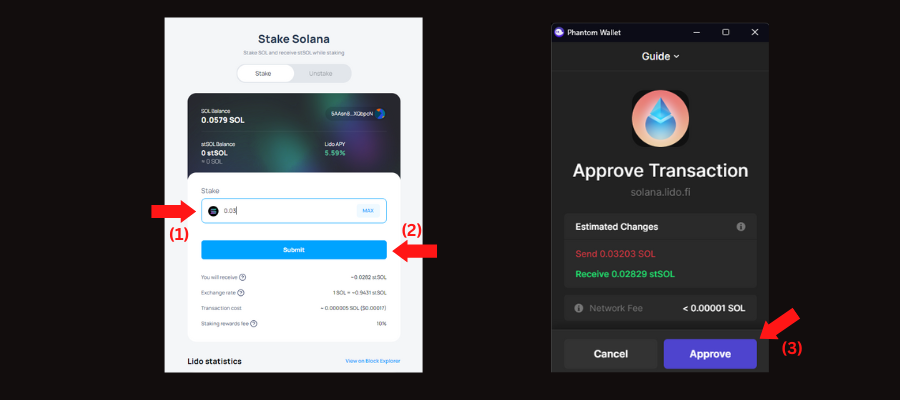
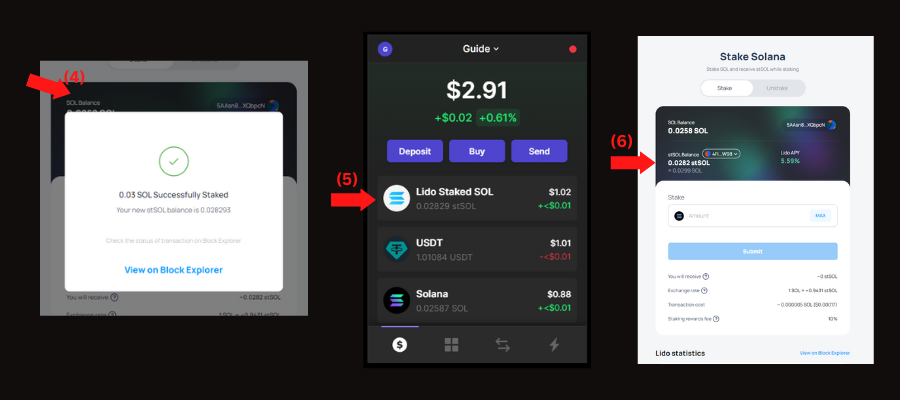
You can now harness the power of liquid staking and earn an additional yield on your staked tokens ($stSOL tokens).
Applications of the Staked Tokens
After depositing your native tokens (SOL) on Lido, you receive st tokens (stSOL). These tokens can be used further to generate additional yield in several ways. There are several applications for the st tokens (stSOL). In this guide, I will go through how to earn additional yield using the stSOL tokens by adding liquidity to protocols.
To earn additional yield, follow the steps below:
- Click on the Solana DeFi option in the navbar.
- Select a liquidity pair.
- You will be redirected to a decentralized applications page. Click on the Connect wallet button.
- Click on the Connect button in your wallet.
- We need to add liquidity to the token pair to get LP tokens. Click on the Add liquidity button.
- Enter the number of tokens you want to add as liquidity for the first token pair.
- Enter the number of tokens you want to add as liquidity for the second token pair.
- Tick the checkbox.
- Click on the Deposit Liquidity button.
- Click on the Approve button in your wallet to confirm the transaction.
- Click on the Stake button.
- Click on the Approve button in your wallet to confirm the transaction.
- Your LP tokens have now been staked and are earning interest.

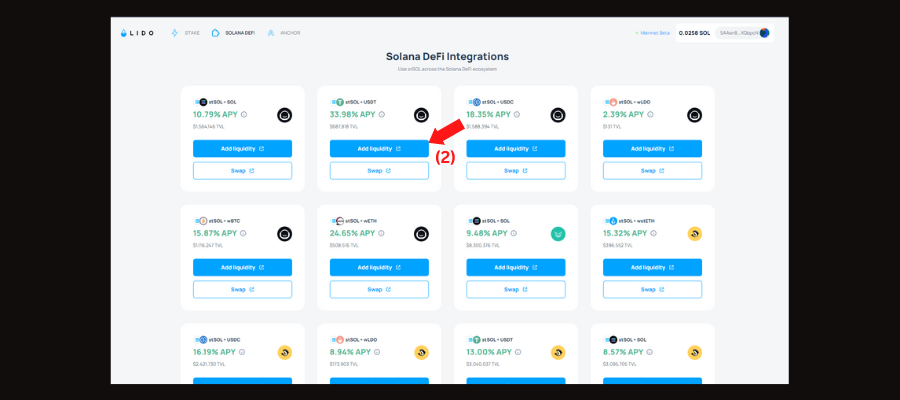
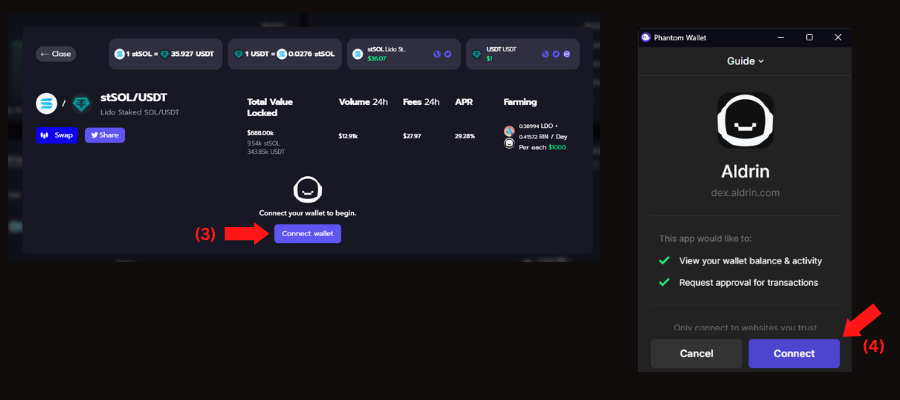
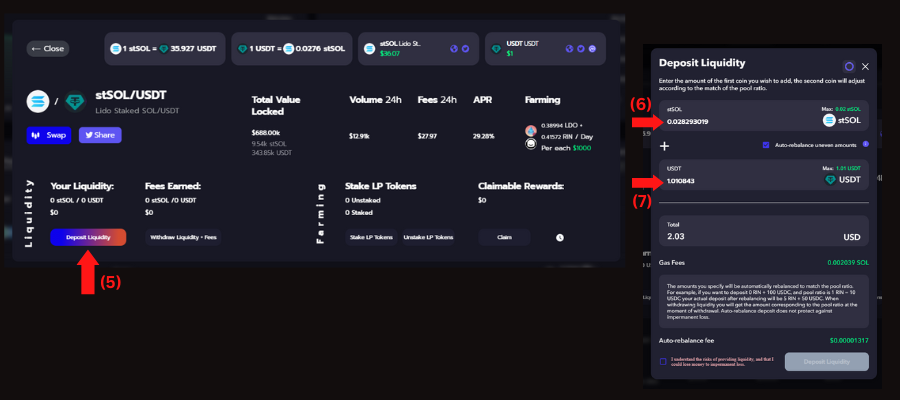
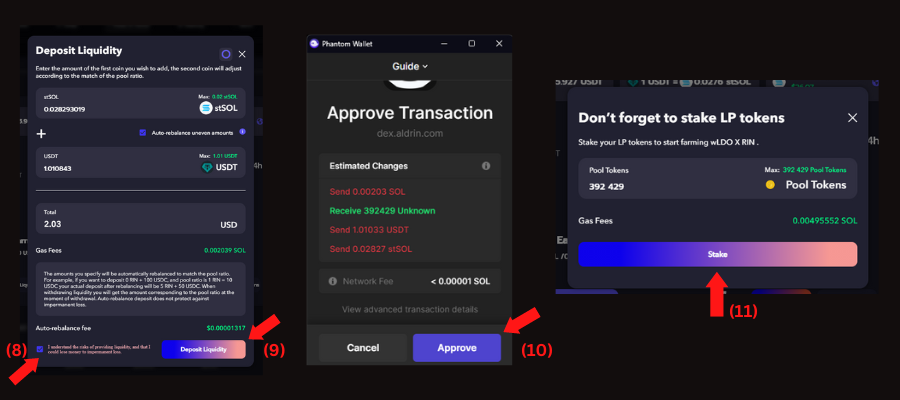
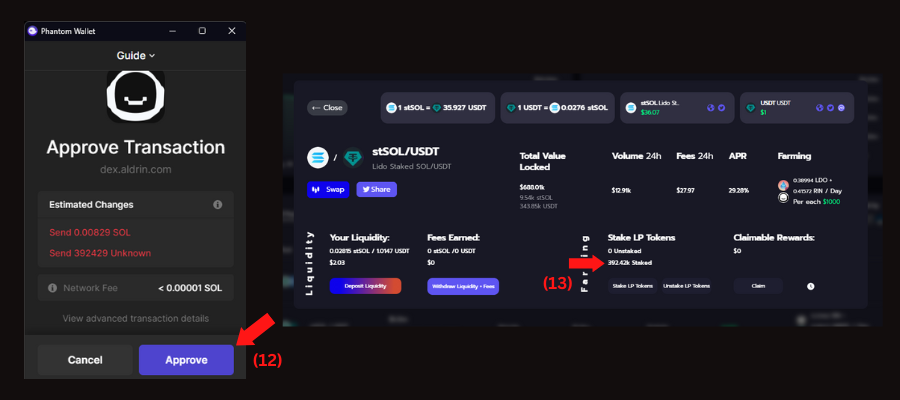
Risks
Since decentralized applications are still in their infancy, they have several risks. Some of these risks include:
Smart contract risks – The working behind decentralized applications and most smart contracts. Smart contracts are pieces of code that perform a certain instruction when a condition is met. These codes May have bugs associated with them, due to which a hacker may be able to hack the contracts and exploit the funds.
Impermanent loss – Impermanent loss refers to the change in the asset’s price from the time you staked it. For example, if you had purchased SOL at $100 and staked it at that price and The current Price of SOL becomes $50, you are at an impermanent loss of 50%.
Price of st token – The price of the staked (st) may depeg from its original price as the staked token has a low market cap. For example, the price of SOL is $100, and the price of stSOL maybe $80.
Conclusion
There you go; you know know how to use Lido Finance to generate additional Yield for staking your assets. The applications of the staked tokens (st) you receive after staking your native tokens are unlimited. Each application may have a separate number of risk associated with it. Hence, please conduct intensive research before staking your assets.
All the content in this article is purely for educational purposes and does NOT provide any financial advice. If you have enjoyed this guide, please let me know in the comments and consider following. Thank you for your time.
Key Takeaways
- Lido finance is a liquid staking decentralized application.
- Liquid staking allows you to generate additional yield for staking your assets.
- Lido Finance currently offers liquid staking for five cryptocurrencies – Ethereum (ETH), Polygon (MATIC), Solana (SOL), Kusama (KSM), and Polkadot (DOT).
- Some of the applications of staked tokens (st) include providing liquidity, swapping, lending, borrowing, and many more.
- NO content in this guide provides any kind of Financial advice.
The media shown in this article is not owned by Analytics Vidhya and is used at the Author’s discretion.





